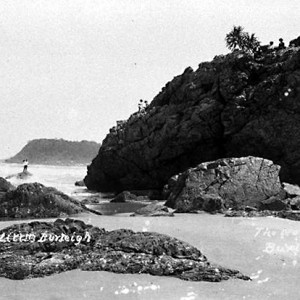
Patrick Fagan arrived in Coolangatta in 1903 and the following year requested that the Nerang Shire Council to clear Hill Street, Coolangatta as he proposed to build in the vicinity.
He built the first section of what was to become Greenmount Guesthouse in 1904-1905 and extensive additions were made in about 1908. Patrick Fagan called the building ‘Greenmount’ after his birthplace in Ireland.
The Greenmount Guesthouse was to be the first of many guesthouses in the Coolangatta area and early photographs show the property surrounded by undeveloped land. Patrick Fagan was the first resident to own a motor vehicle which he used to pick up guests from the railway station at Tweed Heads.
The family ran the guesthouse for more than 35 years until Patrick sold Greenmount in 1944 to Bill Price who extensively renovated the building during the 1940s, 1950s and into the early 1960s. The Price family sold Greenmount in 1972 and in 1978 the original guesthouse was demolished. The Greenmount Beach Resort was constructed on the site.
Guesthouses were built throughout the South Coast in the latter part of the 19th and early 20th century but those at Coolangatta became legendary. In addition to Greenmount, other guesthouses included Stella Maris, Beach House, Coolangatta House, Ocean View and St Leonards with most of these constructed along Marine Parade looking to the ocean.
While accommodation in these guesthouses was fairly basic compared with later standards, the guesthouses were a relatively inexpensive way for couples, singles and families to enjoy a holiday at the beach.
Guesthouses were social venues in themselves, many of them the setting for holiday romances. Competitions were arranged between the various establishments and these events became a source of friendly rivalry amongst the residents. Each guesthouse had its own song and war-cry that was rehearsed and then performed by guests with gusto, often on Greenmount Beach or at local hotels.
With the increasing sophistication of the tourist market, the guesthouses did not appeal to later generations and were largely replaced by apartment buildings since the 1960s.
- Greenmount Guesthouse, Coolangatta, circa 1914. Photographer unknown
- Greenmount Guesthouse, Coolangatta, circa 1910. Photographer unknown
- Bathing boxes on Greenmount beach, circa 1915. Photographer unknown
Sources of information and further reading
- Longhurst, Robert. From Tallebudgera to the Tweed: an early history of the southern Gold Coast. Surfers Paradise: Gold Coast City Council, 1996.
- Winter, Peter. Tales of Yesteryear. Tweed Heads: The Lower Tweed River Historical Society Inc., 2001-2004.
- Jenkins, Lesley. Now and Then. Surfers Paradise: Gold Coast City Council, 2010.
- “Death of Mrs M. Fagan.” The Courier-Mail, 5 Oct 1944: p. 5. http://nla.gov.au/nla.news-article48956782
- “GREENMOUNT.” The Daily Mail (Brisbane, Qld. : 1903 – 1926) 14 February 1922: 10. Web. 29 Oct 2016 http://nla.gov.au/nla.news-article220527824
- “GREENMOUNT” SOLD” Tweed Daily (Murwillumbah, NSW : 1914 – 1949) 30 November 1944: 5. Web. 29 Oct 2016 http://nla.gov.au/nla.news-article194029754








